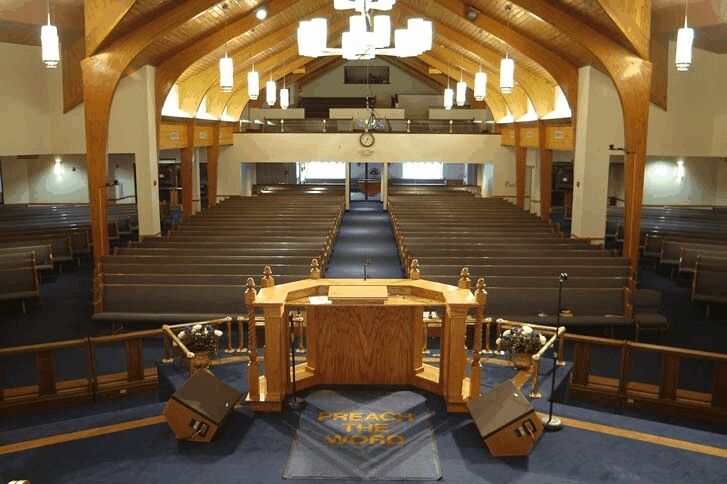How Far Apart Should Church Pews Be?
The church seating layout is common in houses of worship, but it may also be found in lecture halls, performing arts centers, and conference rooms. You might already know it from events you’ve arranged or attended a university seminar or, yes, church. But what precisely is the church seating layout? How far apart church pews should be? How wide is the main aisle between pew sections?

What Is The Church Seating Layout?
While there are many variations, the classic church seating pattern is an arrangement of straight rows facing a pulpit or center area, comparable to theatre seating.
Typically, there is at least one aisleway along the center, if not two, dividing the sitting block into three groups. Designers can choose to arch their seating blocks in tandem with the curve of the stage if it is round. Alternatively, if the venue allows it, you can arrange many portions around the stage’s circumference to create a theater-in-the-round effect.
The church seating plan is quite adaptable, especially if individual seats are used. Add extra rows to the back or position extra folding chairs along the aisleways for a quick fix to enhance the number of available seats.
Pro tip: Maintain an even number of seats in each row. Most event attendees go in groups of two or four, thus utilizing this strategy reduces the odds of people becoming separated from their companions.
Space Between For Walking Between Pews?
Church pews come in a variety of sizes, and the company constructs them to order, giving you a variety of possibilities for arranging pews in the given area. You may pick a single row of long pews, two or three rows of small pews with aisles, or long pews in the center with short benches on either side.
Consider how your church employs aisles when designing the basic layout. Aisles may be used for collection and communion. Do your pastors, acolytes, and choirs enter from the robing room or progress into the sanctuary? Is your congregation more interested informal weddings, or are weddings for non-congregants a significant source of cash for your church? All of these considerations will influence your decision.
Aisles must be at least 4′ wide in order for people to travel comfortably to their pews or for the single-file procession. If you have formal weddings or elaborate processions, 6′ to 8′ may be required instead. Ensure that your aisles are wheelchair and walker accessible.
Unless you utilize kneelers, pews should be roughly 36 inches apart from front to back. More space between the pews will be required if the congregation kneels during the service. Kivett’s Fine Church Furniture offers both wood and metal kneelers.
In general, no more than 14 or 15 people should sit in a single pew. Traditionally, a space of about 18′′ per person is intended; however, this may not be feasible for your group. Do you have a lot of tiny children? Are members of your congregation at ease sitting close together? During a service, does the assembly rise and seat several times? Do you have senior people who may require more space to stand? Observe your congregation during a few services; you may need 21′′ or so per person in your pews.
If you have a choir, you must also consider that choirs are frequently seated by voice: soprano, alto, bass, and tenor are frequently situated individually. Even if you have a small choir, your choristers may sit in one row with ladies and men in another. Choirs may also require additional room for music or percussion equipment. Whether large or tiny, your choir will most likely require more room per person than your congregation. Here is a good resource on how to best arrange your choir’s seating.
Finally, it is the moment for everyone to express their grievances. If you’re replacing your current pews, you’ll want to hear that it’s difficult for ushers to pass through the side space or that the praise band needs a place to sit during the message. Your pews should complement rather than detract from worship.
Connect with a Project Specialist Today!
HOW WIDE IS THE MAIN AISLE BETWEEN PEW SECTIONS?
The normal church chair row spacing is 36 inches from the seatback to the center back. Providing side-step access – meaning that people will generally shuffle sideways along the row due to the restricted space. However, this 36′′ row spacing allows for increased seating capacity in your church because less space between rows means more space available for extra rows in your worship center.
The ideal church chair row spacing is 38 inches from the seatback to the seat back. This allows for what is known as walking access, which means that visitors will generally have enough area to stroll directly between the rows. However, the 38′′ row area allows for less seating than the 36′′ rows, which is an important factor if your church has to cram as many people in for worship as possible.
Your church can use a 40-inch row spacing from the seatback to the seat back for added ease. This allows for what is known as pass-by access, which means that people can generally go directly between the rows, even if someone else is seated or standing in front of their seat. The 40′′ row space will considerably reduce the seating capacity of your worship hall or sanctuary, but it will provide maximum comfort and ease of access.
In the end, many churches will base the spacing of their rows on the number of seats they require or can afford. Starting with the most significant spacing between rows (40′′) when there are few seats available and gradually decreasing the size of the rows as the church grows and requires more capacity. Reducing row space is an excellent technique to accommodate a rising congregation without having to build a new church (expansion).
THE BOTTOM LINE
That’s all on how far a church should be. The distance may vary depending on the church seating layout and the type of pews you opt for. Kivett’s Fine Church Furniture can help you with all your church layout needs. Please do not hesitate to contact us with any questions.

